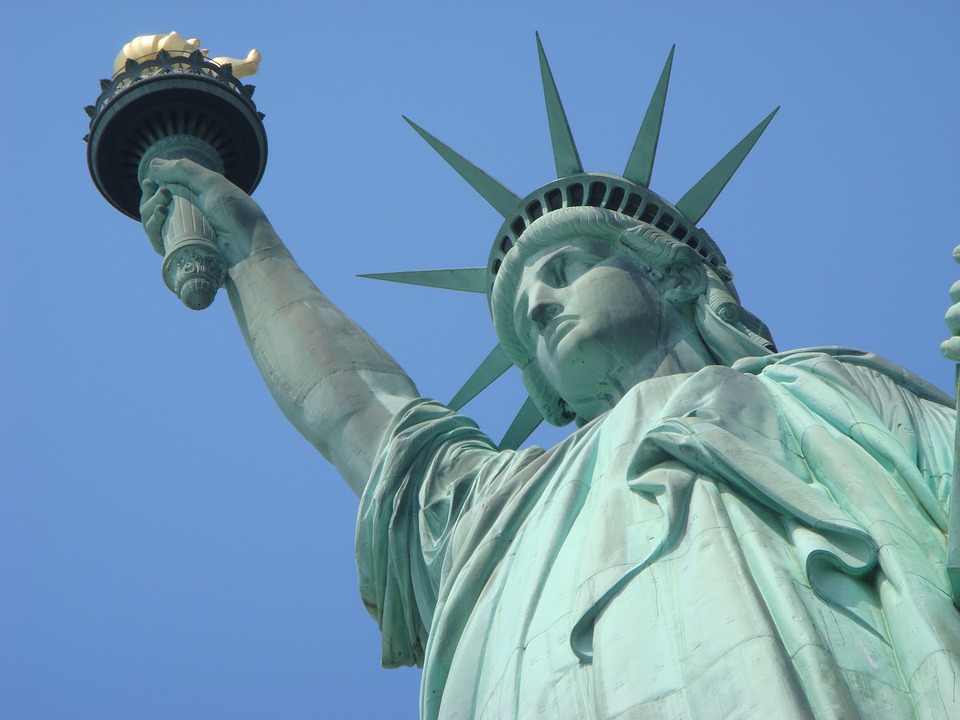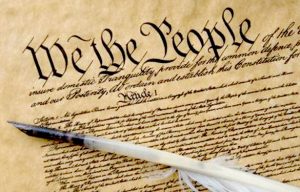On October 28, 1886, a 240-foot tall structure originally named “Liberty Enlightening the World” was revealed to an audience on Ellis Island in New York. This was the tallest structure in New York City, and it is still a great symbol in America today.1 Who would have known that a French sculptor and a French scholar would want to commemorate America for being a free nation for 100 years. These two individuals go by the names Frederic Auguste Bartholdi and Edouard-Rene Laboulaye.2 These two men met and created a sketch for the statue and wanted it to be a symbol of a “freedom-loving republic, a government in which power lay in the hands of the people, instead of a king.”3 The statue would also symbolize the alliance between France and America that began during the American War of Independence against Britain. There is a misconception that the statue was built to represent a welcoming icon for immigrants; however, this was not the initial purpose of the statue.4 France built the Statue of Liberty beginning in 1875. It was made out of 450,000 pounds of copper and steel. It was agreed by both nations that America was to be in charge of the pedestal, which weighed 27,000 tons, for the statue to rest on.5
In the construction of the statue, Bartholdi had used three hundred copper sheets to cover the entire statue. The reason why the statue appears to be green is due to its long exposure to the atmosphere over time. Something interesting is that the features of the statue’s face resemble those of Bartholdi’s mother and the arms resemble those of his wife. The Statue of Liberty is also presented wearing a long robe, which was influenced by ancient Greek and Rome attire. The purpose of this was to serve as a reminder of the ideals of that ancient era.6

The statue is carrying a tablet in her left hand with the year “1776” written on it, which is the year that Congress signed the Declaration of Independence. The significance behind this is to serve as a reminder that “all men are created equal.” It also reinforces the idea that if the government fails to abide by the natural rights of “life, liberty, and the pursuit of happiness,” then the citizens have the right to establish a new government by overthrowing the current one. This tablet also serves as a religious reminder of the Ten Commandments that Moses received when God revealed himself to him on Mount Sinai. The torch that is held in Liberty’s right hand symbolizes the light that the United States carries for the entire world. This suggests that nations should follow America’s political system, according to the French architects. She is also wearing a crown with sun rays beaming from it called a “diadem.” This refers to the ancient sun god, Helios.7
In 1884, the entire statue was done being constructed in France; however, due to its large size, it was packed into two hundred cases to be transported to New York.8 The place where the statue was assembled was Ellis Island. The statue is known as the “centerpiece of a magical American place,” since her popularity will grow through being imaged in magazines, newspapers, postcards, among other things.9 One issue with building the statue was the funding for the statue’s pedestal, since the U.S. government was not willing to pay for the construction of it. One way this was done was by fundraising and donations from various contributors, such as Joseph Pulitzer and Emma Lazarus. Pulitzer published in the New York World newspaper asking for donations for this statue. Lazarus wrote a poem at a fund-raising auction to help the funding of the statue’s pedestal.10
The unveiling of the statue was on a foggy, raining day on October 28, 1886. Millions of people witnessed this revelation and took part in a parade held in Manhattan. The President at the time was Grover Cleveland. He gave a speech at the ceremony about freedom and America’s democracy. However, immigration was not mentioned in this speech. The Statue of Liberty was the first major icon that immigrants would see as they came to America. The Statue of Liberty is an important icon in American history and is still a valued symbol today. The story behind its development and upbringing involved the interaction between France and the U.S. The purpose of the construction of this statue is to recognize America’s political system, its dependence on the ideals of freedom, and how America serves as a symbol of hope and a new start for immigrants.11
- Dictionary of American History, 2003, s.v. “Statue of Liberty,” by John Higham. ↵
- UXL Encyclopedia of U.S. History, 2009, s.v. “Statue of Liberty,” by Sonia Benson, Daniel E. Brannen, Jr., and Rebecca Valentine. ↵
- James L. Outman, Statue of Liberty In U.S. Immigration and Migration Reference Library (Detroit: UXL, 2004), 364. ↵
- James L. Outman, Statue of Liberty In U.S. Immigration and Migration Reference Library (Detroit: UXL, 2004), 364-365. ↵
- Dictionary of American History, 2003, s.v. “Statue of Liberty,” by John Higham. ↵
- James L. Outman, Statue of Liberty In U.S. Immigration and Migration Reference Library (Detroit: UXL, 2004), 366-367. ↵
- James L. Outman, Statue of Liberty In U.S. Immigration and Migration Reference Library (Detroit: UXL, 2004), 368-369. ↵
- James L. Outman, Statue of Liberty In U.S. Immigration and Migration Reference Library (Detroit: UXL, 2004), 369. ↵
- Dictionary of American History, 2003, s.v. “Statue of Liberty,” by John Higham. ↵
- James L. Outman, Statue of Liberty In U.S. Immigration and Migration Reference Library (Detroit: UXL, 2004), 365-370. ↵
- James L. Outman, Statue of Liberty In U.S. Immigration and Migration Reference Library (Detroit: UXL, 2004), 370-374. ↵



93 comments
Blanca Martinez
I knew the Statue of Liberty was from France, but I didn’t know who were the people who invented it. It was also very surprising to find out how much material it took to be made. Another fact that is quite surprising is where the inspiration came from, who would have tought that it came from one of the creator’s mom and wife. This article was fun to read, especially with all the new information I learned about the statue.
Kelley Salinas
Before reading this article, I had always thought that the Lady Statue of Liberty was a symbol of hope for immigrants. It was interesting to find out that it was a gift from our French allies as a symbol of our “freedom-loving republic, a government in which the power lay in the hands of the people, instead of a king.” It was also amazing to find out that it was originally going to be called “Liberty Enlightening the World.” This article was a great read, flowed well and very informative.
Josselyn Arrieta-Meraz
The fact that there is a statue that signifies so many factors and promises that this nation carries, is a daily reminder to those who may at times be employing otherwise. The Statue of Liberty is that one statue that you just simply know of when growing up, many may think of Times Square when New York is mentioned while others simple think of the Iconic figure that symbolizes so many attributions for our country that reminds us every day that we are all immigrants, we are simply living in the land of the free.
Brianda Gomez
Before reading this article, I did not know much about the statue of liberty. I only knew this Historical monument was a must-see for many tourists. What really surprised me, was that it was built by a French scholar and sculptor. It goes way back to 1886 when it was opened and reveled to the people of New York City. This 131-year-old monument was a representation of a ‘Free nation”, the United States. Great Article!
Matthew Rios
Truly a wonderful gift for all of us. I was glad you pointed out the significance, or rather lack thereof regarding immigration. Too many people seem to misunderstand, or not know at all the original intent regarding the creation of Statue of Liberty. Three years ago though I visited and was thankful I got to. Too many people will go on living without witnessing for their very eyes, the symbols of our democracy.
Mariet Loredo
Fantastic article! I had no idea that the Statue of Liberty was first called Liberty Enlightening the World, that was a great first name. The Statue of Liberty is a powerful symbol of America. It represents freedom and a government that practices a democracy, that gives the people the power. This article really explains how the Statue of Liberty shows democracy and freedom.
Sebastian Castro Ramos
On my US History class I learned that the French gave the Statue of Liberty to the United States as a gift, but that was all I was taught. It is interesting how the French wanted to celebrate the 100 years of independence by gifting them a symbol of this country’s political system, a system regarded as ideal. The work of the architects was splendid.
Great article, very informative.
Eduardo Foster
It’s actually amazing the information provided on the article! I didn’t know France gave the statue for the 100 years of independence to the United States. It’s also interesting the fact that due to erosion the statue is gain its color green. It is a memorable statue and one of most famous places tourists like to visit every year! Nice article and keep it with the good work.
Yahaira Martinez
Since i have always had an interest in science, i distinctly remember being taught why the statue of liberty was green and how and when it was made. Even though i already had quite extensive knowledge on this topic, the article itself still managed to teach me even more about it. I was aware of the science aspect of the Statue itself and some history but i didn’t know the real reason as to why France gave us the statue and it was very intriguing for me. Very great and informative article !
Ernie Sano
Symbolism is an effective way of inspiration. The Statue of Liberty creates a sense of welcome and change in societal structures that personifies progression in a time period that was rather glum. It is important to remind citizens that they should remain hopeful and that their lives will get better or a revolt or rebellion could be in the making, as history often shows.